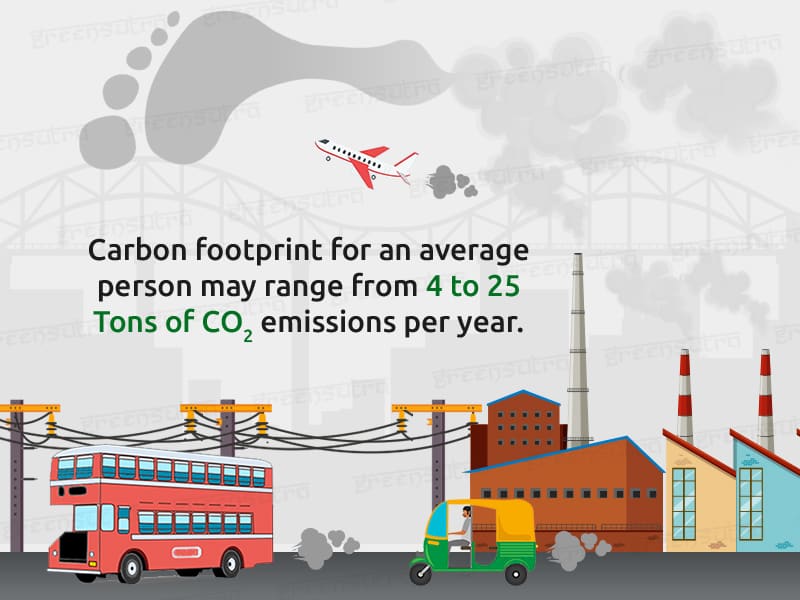Carbon footprint for an average person may range from 4 to 25 Tons of CO2 emissions per year.

Carbon footprint is referred to as the physical measure of impact inflicted on the environment caused by an individual, organization or community.
A Carbon Footprint is defined as the total measure of products and by-products contributing to greenhouse gases that can be produced either directly or indirectly by and to support human activities.
In short, a Carbon Footprint is the sum of all emissions in equivalent terms of CO2 induced by an individuals activities in a given time frame.
Carbon Footprint is usually expressed in:
- Equivalent metric tons of carbon (C) over a period of one year – (C)e MT /year
- Equivalent metric tons of carbon dioxide (CO2) over a period of one year – (CO2)e MT /year
Carbon Footprints can be measured for:
- Individuals
- Companies
- Industries
- Establishments (Residential, Commercial, Educational, etc.)
- Specific Processes
- Specific Areas
- Countries
Significance of Carbon Footprint
Since carbon footprint is a measure of greenhouse gases in equivalent terms of carbon dioxide, it plays an instrumental role in studying and observing the behavioral impacts on global warming and the resultant climate change.
By consistently estimating and tracking the carbon footprints, different methods can be formulated to either control or reduce the carbon footprints which can help :
- To limit the rise in temperatures
- Increase in the use of sustainable processes and practices
Estimating Carbon Footprint
Generally a carbon footprint can be estimated based upon the cumulative and or independent practices.
The estimation process includes the values of all the greenhouse gases that are released into the ecosystem or the environment as a result of human activities and expresses it as a single number in terms of Carbon Dioxide (CO2).
| Greenhouse Gas | Chemical Formula | Global Warming Potential | Atmospheric Lifetime (years) |
|---|---|---|---|
| Carbon Dioxide | CO2 | 1 | 100 |
| Methane | CH4 | 25 | 12 |
| Nitrous Oxide | N2O | 298 | 114 |
| Chlorofluorocarbon - 12 | CCl2F2 | 10,900 | 100 |
| Hydrofluorocarbon-23 | CHF3 | 14,800 | 270 |
| Sulphur Hexafluoride | SF6 | 22,800 | 3,200 |
| Nitrogen Trifluoride | NF3 | 17,200 | 740 |
Factors affecting Carbon Footprint
It is safe to say that Carbon Footprints are directly proportional to the generation of greenhouse gases. This means that if an individual, organization or community is responsible to generating huge amounts of greenhouse gases, the respective Carbon Footprint is going to proportionally large.
All sources that generate some form of greenhouse gases can be considered as factors affecting Carbon Footprint.
Some of the factors that affect the carbon footprint are:
- Energy Production (contributor)
- Transportation (contributor)
- Industries (contributor)
- Agriculture (contributor)
- Commercial & Residential Establishments (contributor)
- Land Use & Forestry (offsetter)


 1. Carbon Footprint
1. Carbon Footprint